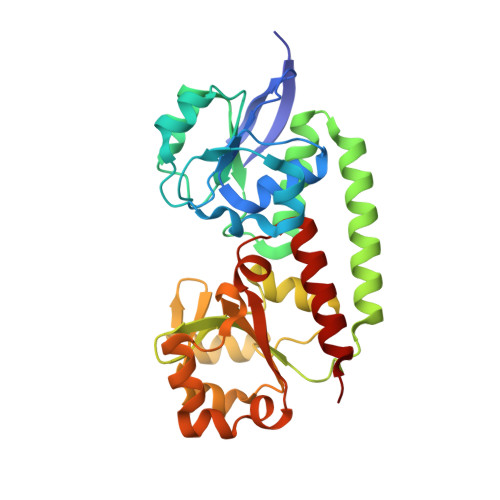The Staphylococcus aureus siderophore receptor HtsA undergoes localized conformational changes to enclose staphyloferrin A in an arginine-rich binding pocket.
Grigg, J.C., Cooper, J.D., Cheung, J., Heinrichs, D.E., Murphy, M.E.(2010) J Biological Chem 285: 11162-11171
- PubMed: 20147287
- DOI: https://doi.org/10.1074/jbc.M109.097865
- Primary Citation of Related Structures:
3LHS, 3LI2 - PubMed Abstract:
Staphylococcus aureus uses several efficient iron acquisition strategies to overcome iron limitation. Recently, the genetic locus encoding biosynthetic enzymes for the iron chelating molecule, staphyloferrin A (SA), was determined. S. aureus synthesizes and secretes SA into its environment to scavenge iron. The membrane-anchored ATP binding cassette-binding protein, HtsA, receives the ferric-chelate for import into the cell. Recently, we determined the apoHtsA crystal structure, the first siderophore receptor from gram-positive bacteria to be structurally characterized. Herein we present the x-ray crystal structure of the HtsA-ferric-SA complex. HtsA adopts a class III binding protein fold composed of separate N- and C-terminal domains bridged by a single alpha-helix. Recombinant HtsA can efficiently sequester ferric-SA from S. aureus culture supernatants where it is bound within the pocket formed between distinct N- and C-terminal domains. A basic patch composed mainly of six Arg residues contact the negatively charged siderophore, securing it within the pocket. The x-ray crystal structures from two different ligand-bound crystal forms were determined. The structures represent the first structural characterization of an endogenous alpha-hydroxycarboxylate-type siderophore-receptor complex. One structure is in an open form similar to apoHtsA, whereas the other is in a more closed conformation. The conformational change is highlighted by isolated movement of three loops within the C-terminal domain, a domain movement unique to known class III binding protein structures.
- Department of Microbiology and Immunology, Life Sciences Institute, The University of British Columbia, Vancouver, British Columbia V6T 1Z3, Canada.
Organizational Affiliation:



















